Louisville Free Public Library
Introduction
Text-to-speech Audio
Images
Louisville Free Public Library (image from Insider Louisville)

LFPL lobby (image from Broken Sidewalk)
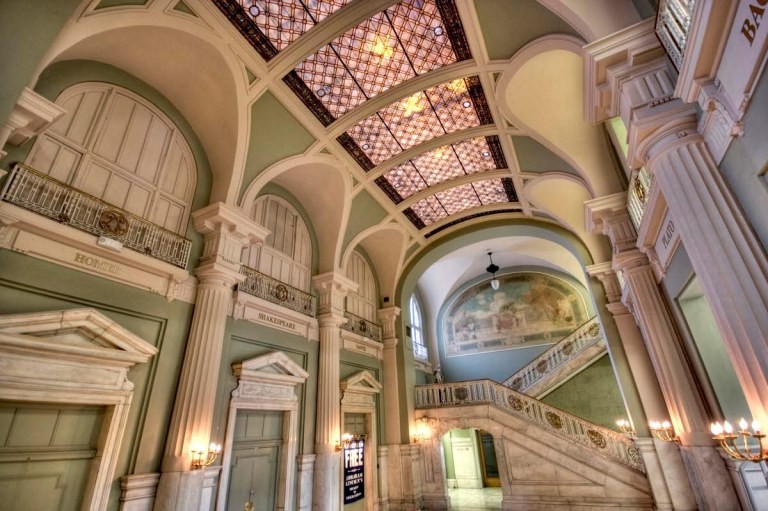
Another view of the lobby, previously the Delivery Room (image from the LFPL Foundation)
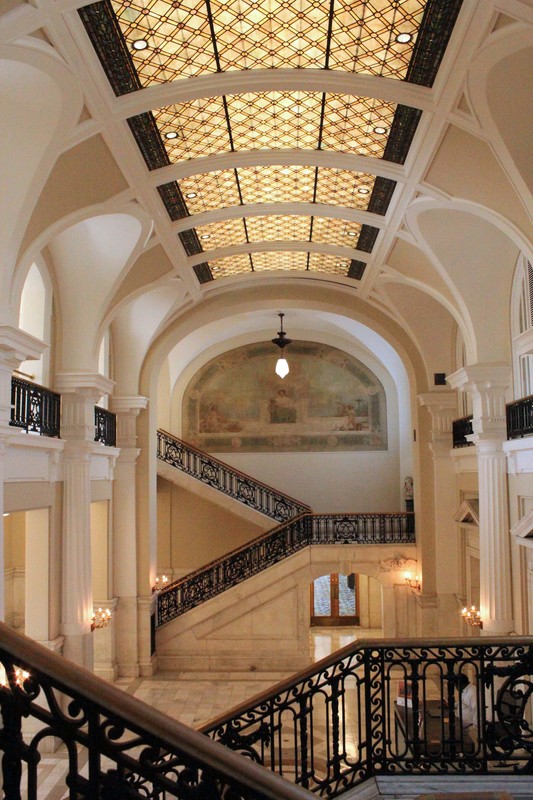
The Delivery Room ceiling under construction in 1907 (image from the LFPL)
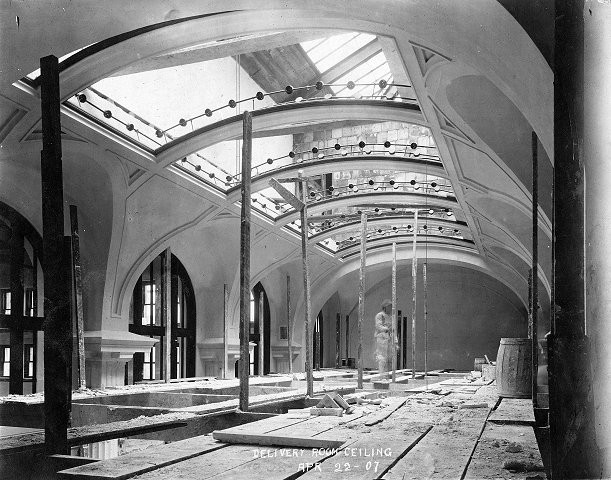
East view of the building site under construction in 1906 (image from the LFPL)
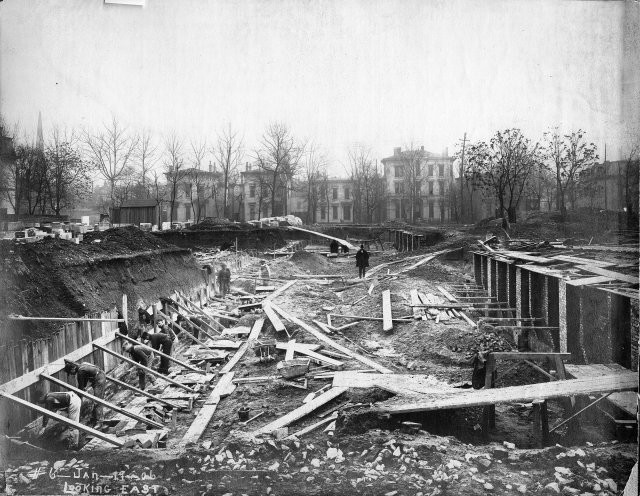
Bird's eye view of construction from the south, Sept. 1906 (image from the LFPL)

Sculptors at work on one of the library's friezes, 1907 (image from LFPL)
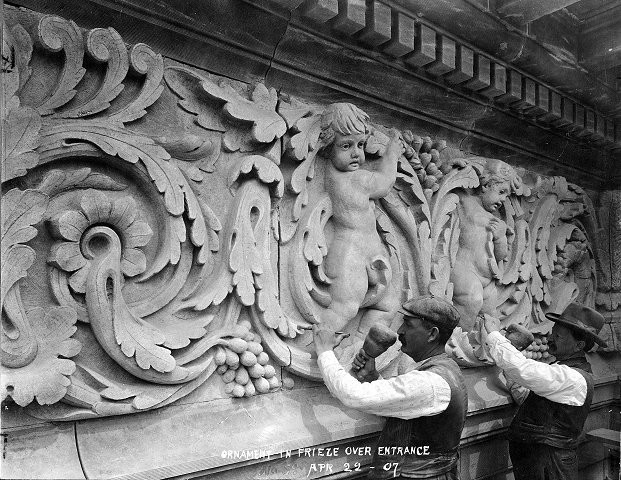
The Lincoln Statue, appearing to float on the 1937 floodwater (pedestal is three feet high) (image from Insider Louisville)
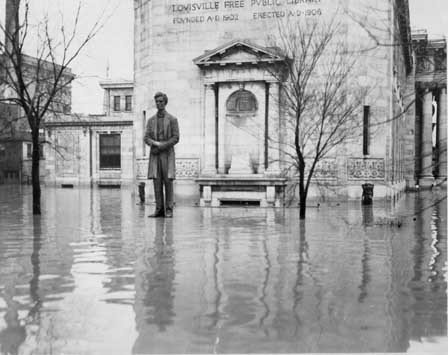
Backstory and Context
Text-to-speech Audio
A group of five Louisvillians
including Mann Butler founded the Louisville Library Company, based around a
small collection within the old Court House, in 1816. It was the first of
several underfunded attempts throughout the nineteenth century to provide the
city of Louisville (or at least, those citizens able and willing to pay for its
services) with a library. The lottery-funded Public Library of Kentucky was the
first to attempt a free, public library in Louisville in 1871. Their work culminated in the purchase of Weisinger Hall (previously
Kaufman's Department Store), where the citizen-organized Polytechnic Society of
Kentucky funded the small collection and kept the vision of a library alive
until the turn of the century. The Polytechnic Society and Public Library of Kentucky
merged in spite of controversy over offering free services, forming the Louisville
Free Public Library in 1902. The merger provided a temporary home and 65,000
volumes for the fledgling library. With a grant from philanthropist Andrew
Carnegie acquired through the efforts of the Scottish Society, the library's
main site began construction in 1905 and officially opened in 1908, after
delays due to construction worker strikes. As the library prospered, over
thirty branches were added (though some later closed), including the historic
Western Colored Branch (today's Western Branch), which was the first Carnegie-housed
library in the U.S. built exclusively for African Americans.
History of the Main Branch at York Street
The Main Branch of the LFPL was designed in the Beaux-Arts style by New York firm Pilcher and Tachau (the latter a native Louisvillian), and is considered one of the finest examples of Beaux-Arts architecture in the state of Kentucky. The Delivery Room (present-day foyer) is a two-story Louis XVI style space with stained-glass, barrel-vaulted ceiling, white marble columnns, neo-Renaissance murals by Theodore L. Wilberg, and two staircases with bronze and iron railings. Its open stack room was an innovation at the time, and a popular feature upon the building's formal opening in 1908.
In addition to books, the LFPL contained
a natural history museum, an armory including Daniel Boone's rifle along with
Medieval weapons and armor, collections of American Indian weapons and beads,
and paintings, drawings, etchings, bronze engravings, and statues. In addition,
it was the first local home for Louisville's Egyptian mummy, Then-Hotep (now, along
with the natural history collection, at the Kentucky Science Center). The
library's thirteen-foot bronze statue of Abraham Lincoln, sculpted by George
Grey Barnard and donated (along with fifteen paintings) by Mr. and Mrs. Isaac W. Bernheim, was dedicated on
October 26, 1922, and attended by Lincoln biographer and muckraker Ida B.
Tarbell. It is a long-held tradition that rubbing Lincoln's toe is good luck.
Along with 70% of Louisville, the library and its collections were submerged during the Great Flood of 1937, with the high water reaching thirty feet above flood level. Collections of rare bird's eggs were crushed, artwork endangered, taxidermy specimens and moth and butterfly collections damaged, and Then-Hotep the mummy all but destroyed. She was saved through the efforts of Lucien Beckner, director of the institution which is known today as the Kentucky Science Center (then the Museum of History and Science), who used equipment at the 3rd Street Louisville Gas & Electric Company to dry the mummy out. The building itself suffered damage as the books expanded as they took on water and broke the supports holding up the shelves and the ceilings, and naturally many of the books themselves were damaged or destroyed.
Nonetheless, the library thrived, becoming the first United States library with its own FM-radio station, WFPL, in 1950. A few years later, a second station, WFPK, was added. In 1969, an 110,000-square-foot modern concrete-and-glass addition was constructed at the rear of the building, allowing more space for programs and departments including the Junior Art Gallery in the Children's Library, the Audio-Visual Department, the Kentucky Division, rare books and special collections, the Foundation Center, the Talking Book Library for the visually impaired, and a U.S. Government document depository. Along with the addition, a new sculpture of Benjamin Franklin, sculpted by Felix de Weldon (sculptor of the Iwo Jima U.S. Marine Corp War Memorial), was added to the grounds.
In 2009, another major Louisville
flood devastated the library's main floor as seven inches of rain fell in
seventy minutes. When the building was repaired following the disaster,
measures were taken to prevent future flood damage, including the addition of
holding cisterns for excess water.
Sources
1. Hedgepeth, Marty Poynter. "Louisville Free Public Library." National Parks Service, National Register of Historic Places. June 29, 1979. Accessed March 15, 2017. https://npgallery.nps.gov/NRHP/GetAsset/16e04b8a-4a1f-4750-a1da-79cee75b70a5?branding=NRHP.
2. Kentucky Historical Society. Historical Marker Database: Jefferson County. Accessed March 10, 2017. http://migration.kentucky.gov/kyhs/hmdb/MarkerSearch.aspx?mode=County&county=56.
3. Louisville Free Public Library. Official website. Accessed May 17, 2014. http://www.lfpl.org/lfpl-history.htm.
4. Serchuk, David. "Inside Metro: The delightfully odd
history of the Louisville Free Public Library." Insider Louisville.
October 6, 2014. Accessed March 17, 2017. http://insiderlouisville.com/metro/communities/library/.
